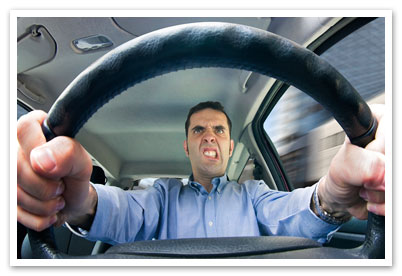We carry our emotions with us everywhere we go, even on the road. It seems like people are more restless and quick to anger on the road than before. While you can’t control everyone else’s actions on the road, you can certainly control your own.

Aggressive driving and road rage are sometimes used interchangeably, but there’s a difference between the two. Aggressive driving is a moving violation, or a combination of moving violations, that puts other people in danger on the road. Aggressive driving can look like speeding, improperly changing lanes, failing to yield the right-of-way, and ignoring traffic signals and devices.
Road rage, on the other hand, is a criminal offense. It’s an elevated form of aggressive driving where the driver commits an assault with their vehicle. Road rage can be a driver stepping out of their vehicle to start a fight with someone, intentionally causing a collision with another driver, or even threatening other drivers with a weapon. Both of these offenses carry heavy consequences.
It’s okay to be annoyed or even mad at another driver, but it’s not okay to retaliate against that driver in any way. Here are some tips for controlling your anger on the road:
Don’t take it personally. If another driver seems mad at you for something, that’s their problem. It’s not your job to return their anger. If another driver is driving "badly," have some empathy for them. You never know what someone else is going through.
Take a few deep breaths. It’s hard to control intense emotions. Taking a few deep breaths lets your brain know it needs to settle down. One way to do this is to breathe in deeply for four counts, then release your breath for eight counts. After doing this a few times, your body will feel calmer and more regulated, even if you’re still feeling angry emotionally.
Take a break. It’s important to pay close attention to the road as you drive. If relaxing your muscles and a few deep breaths don’t work right away, you may need to pull over in a safe place and park your vehicle. Let in some fresh air and continue to take deep, calming breaths. Don’t get back on the road until you can drive with your full attention on the road.
While everyone copes with their emotions differently (or sometimes not at all), physical things like deep breaths and releasing tension in your body are proven ways to pause your anger and prevent it from escalating to road rage. Chances are you’ll still feel a little angry when certain situations arise, but that’s okay as long as you handle your anger appropriately and refuse to escalate it to a dangerous level.
If you want to learn more about safe driving, or if you want to keep points off your driver record, take a look at our online courses! Click here to visit our website to see the online courses we offer in your state! You may even be able to get a discount on your insurance by taking one of our courses.